Note: Yale School of the Environment (YSE) was formerly known as the Yale School of Forestry & Environmental Studies (F&ES). News articles and events posted prior to July 1, 2020 refer to the School's name at that time.
The
Sri Lanka Program for Forest Conservation (SLPFC), a Yale-based project headed by F&ES Prof. Mark Ashton, this year launched a postgraduate fellowship program that provides practical and professional development experience in tropical forest conservation.
The first three fellows,
Blair Rynearson ’15 M.F.,
Logan Sander ’15 M.F., and
Laura Lutttrell have been in Sri Lanka since October.
The Sri Lanka Program for Forest Conservation is devoted to research, education and extension of tropical forest conservation in southwestern Sri Lanka. It has several endowed programs that enable faculty, doctoral, masters and undergraduate students from the Universities of Sri Jayewardenepura, Peradeniya, Uva Wellassa and Yale to study tropical forest conservation at a field station located in the village of Pitekele and the adjacent Sinharaja MAB World Heritage Forest.
Working with villagers and the SLPFC, the fellows learn tropical taxonomy, nursery propagation, and have helped develop a traditional tree garden that provides foods, timbers, medicines, and spices. The garden is being designed to serve as a living demonstration for university curricula and practitioner extension. Once complete, the program will provide downloadable information from the NGO’s website on the cultural, ecological, and economic diversity of plants cultivated in traditional gardens in Sri Lanka.
In an ongoing series of posts, Rynearson, Sander, and Luttrell share their experiences of learning about — and then developing — a traditional Sri Lankan village tree garden.
Oct. 24, 2016
By Laura Luttrell
We were treated to a spectacularly easy and comfortable arrival both into the country and to our home site!
Professor Singhakumara, the director of the NGO and a professor at the University of Sri Jayewardenapura, picked us up at the airport at an unreasonable 1 a.m. and transported us to a comfortable bed and breakfast. The next day, he brought us around Colombo, helping us get set up for our time in Sri Lanka, then drove us the 4-hour journey to our now home in a comfortable air conditioned van. We had the royal treatment and are so thankful for the easy transition.
Our home (the field station) is very comfortable with everything we need. It is tucked up on a hill at the end of an intermittently paved dirt road (also known as Pitakele village) amongst the ferns and orchids. We have a fantastic cook/caretaker who looks after the house and makes us three Sri Lankan meals everyday, usually including at least rice, vegetables, coconut and curry. We also had the good fortune of sharing the house for a few days with a Sri Lankan researcher who toured us around the Sinharaja Forest Reserve and helped us understand the culture a little better. He speaks English and also helped us get started learning Sinhala (the local language). I’ve now memorized the alphabet and am reading like a first grader (although I still don’t know what the words mean). I’m probably up to about 50 words so far. Really though, the natural world is the main attraction here...
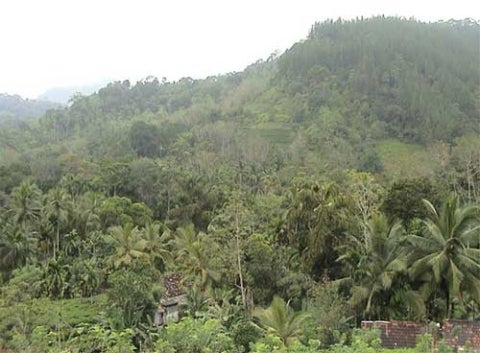 A view of the village of Pitekele and their tree gardens, tea and rice cultivation. The field station is located at the top of the valley adjacent to the rain forest with the village downstream following the river and valley.
A view of the village of Pitekele and their tree gardens, tea and rice cultivation. The field station is located at the top of the valley adjacent to the rain forest with the village downstream following the river and valley.
While swinging in a hammock on our sizeable veranda, I daily witness many tropical birds, monkeys, wild jungle fowl, lizards, and of course a gorgeous panorama of tropical trees and plants. While we have had surprisingly less rain than we expected, this is also an excellent place to enjoy the sound and smell of clean water falling from the sky.
The weather and environment is much more comfortable than we expected as well. While it is of course humid, it seems less humid than DC in the summer... and the temperature mostly stays comfortable. The evening temperature is perfect for sleeping and the mosquitos are shockingly absent... In many tropical places, we would sweat without moving around or doing anything. Here, we are lucky that this is not the case; we get sweaty only when we are active.
Although we have a shower at home, we usually choose to indulge in a cool swim at the head of our exceptionally clean river to rinse away the day’s heat. When the current is right, we stand under the waterfall for a massage as well!
This week, Logan and Blair’s former professor, Mark Ashton, and his colleagues Professors Singhakumara, Sisira Ediriweera, and Nimal and Savi Gunatilleke, all members of the steering committee for the Sri Lankan NGO hosting us, will arrive to spend a week better acquainting us with what our next six to eight months will look like and the projects we’ll be working on.
Nov. 10, 2016
By Laura Luttrell
About two weeks ago Logan and Blair’s former professor, Mark Ashton, came for a visit. With him, he brought four prominent Sri Lankan professors of ecology and several students, as well as several local villagers who have been involved in their conservation projects and research over the years. Our new home bustled with activity and we set out into the forest to learn and get acquainted. We were given a crash course by Sri Lanka’s preeminent forest ecologists covering a huge variety of plants, local ecosytems and culture. We toured home gardens, climbed a few small mountains, and made a rapid descent down an overgrown forest path in a monsoon- like downpour.
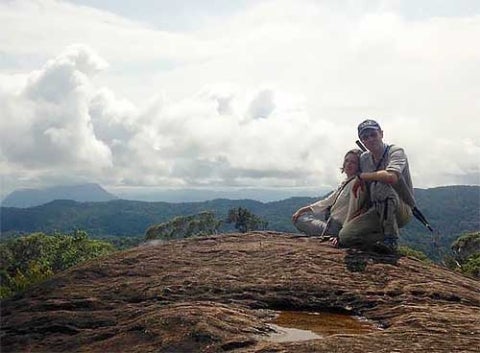 After arriving in Sri Lanka the fellows toured home gardens, and climbed a few small mountains.
After arriving in Sri Lanka the fellows toured home gardens, and climbed a few small mountains.
Professor Ashton also gave us a clearer idea of the project he would like us to work on while we are here... we will collect and document information about the cultivation of home garden plant species, build and maintain a plant nursery, and design and install a home garden for the field station complete with labels and ethnobotanical information, so the site can be used for education about home garden techniques and implementation. Our garden will likely include many of the common fruit trees here like coconut, papaya, guava, avocado, and jack. We’ll also plant bananas, pineapples, herbs, peppers, and lots of pretty flowers, but that’s just mentioning a very few of the hundreds of plants that the villagers here cultivate.
In order to be successful with this project, we have begun learning Sinhala (the local language), which if we become proficient, will give us the opportunity to directly get to know and talk to villagers about their lives and gardens. We will also be hiring a translator to help us gain more specific information, but after Peace Corps, Logan and I have realized that our own language acquisition is really key to integration and understanding the culture. Since my last post, we’ve learned many more words and have begun making sentences and asking basic questions.
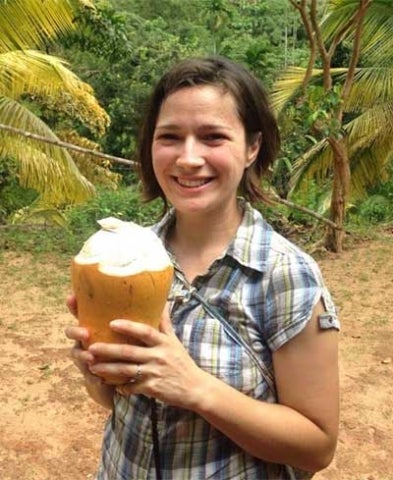 Laura drinks a king coconut.
Laura drinks a king coconut.
We are happy with our progress, but are also reminded of just how helpless and inept we can feel without common language. Even though we are waiting for our language to get better and for our translator to be available, we’ve managed to visit a couple of homes and tour their gardens. This got us started recognizing plants and learning their Sinhala names. Our neighbors in Pitakele have been wonderful hosts and patient teachers of both the Sinahala language and the uses of the plants they cultivate.
Meanwhile, we established a site for the nursery and have cleared the area. We had some lessons on how to use the local tools for clearing and chopping (a sort of hooked-machete and a hoe-like mattock) and went to work. We also took a trip to the “local” hardware store (~2 hours walking/busing to our closest town) and bought some tools and supplies to get started. Next up, we’ll help cut down a palm tree to make planks that will hold up our little seedlings and start meeting more villagers. Overall, we’re in awe of the beauty of this spectacular place, have adapted well to the climate, culture, and delicious food and are very excited to about the work ahead on the home garden.
Nov. 23, 2016
By Logan Sander
After a few weeks of getting oriented and familiarized with our Sri Lankan village life, we began work on our home garden plant nursery. For us, the nursery will be one of our primary work sites, a place where we can grow, multiply and nurture along the plants that will come to make up our homegarden, tea fields and any other forestry or agricultural project we undertake.
Under the guidance of Professors Ashton, Gunatilleke, Singhakumara and our caretaker Somaratne, we selected a site for the nursery near the field station on a flat alluvial terrace next to the stream. In this location we have ready access to water and any construction materials we might need.
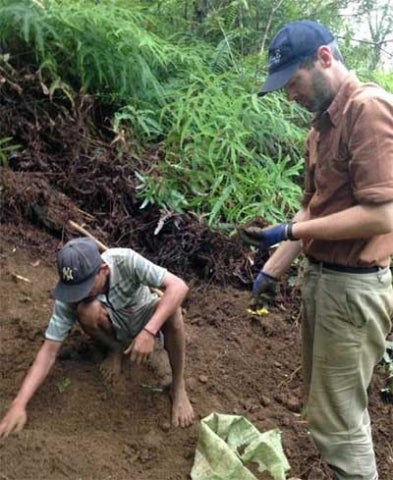 Tillekaratne explaining the intricacies of soil.
Tillekaratne explaining the intricacies of soil.
In many ways the proper functioning of a nursery is as much a social consideration as an ecological one — we expect to visit the nursery several times a day to check on and water plants. It’s important that the nursery be conveniently located, otherwise it’s all too easy for the spontaneous nature of our day-to-day lives here to lead to neglecting the plants. Forgetting to water germinating seeds on a single rainless day could result in their demise (admittedly, rainless days seem rare here in the “rainforest”).
After a rough delineation of the site, we set about clearing the area. Somaratne led the way, showing us how to use the local machete-equivalents (pehiyas and katas) to cut away small trees and ferns. We chopped and raked roots with the idella, a large hoe-like tool used locally for everything from mixing cement to maintaining rice paddies. While crashing around in the bushes we found a small mine, which pretty much consists of a vertical hole in the ground, about 2 meters square. This province (Sabaragumara) is renowned for the gems buried beneath the shallow soils. Several streets in the provincial capital of Ratnapura (“City of Gems” in Sanskrit) are filled with small-scale gem miners and merchants.
We also came across a few polybags scattered amongst the leaf litter — apparently ours isn’t the first nursery to be located here! In terms of light management, we cut a few large branches of adjacent trees that blocked light to the ground where our plants will be located. Our closest neighbor, Tillekaratne, and his climbing skills came in handy for this. Within seconds of deciding what to cut he had sprung up the tree, cut the limb, and slid down the trunk like it was a fireman’s pole. At ground level, we retained most of the seedlings of the late-successional trees (mostly Dipterocarps — a subject for a later posting). These seedlings won’t interfere much with light reaching our nursery beds, but will become the future forest when the nursery is eventually abandoned (hopefully after many years of good use!). Ultimately, we ended up with a 15-by-20-meter clearing that permits at least half of the sunlight to reach our plants. If we need to, it will be easy to expand the nursery into the secondary forest.
Next, to build the nursery beds, we needed some wooden boards. The plants in our nursery will be grown in polybags — 4- to 6-inch diameter, 8- to 10-inch long tubes of black plastic sealed at one end with a few drainage holes poked into the bottom. As a result, our nursery beds simply provide a structure to hold the polybags upright and make it a little easier to organize our inventory. We decided on a rough size (8- to 10-feet long, 4-feet wide — for ease of watering/weeding) and set off into our forest to cut two large kitul palms to make into wooden boards (more on this in the next post: “’Shopping’ for lumber”). After moving the finished boards to the nursery we quickly built the beds: two short boards, two long boards, and 10 to 20 handcrafted wooden stakes to hold them in place. Within a few hours, and after some minor work modifying a nearby hose, we had 10 nursery beds complete with a central water spigot!
 Blair and Tillekaratne after a long day’s work.
Blair and Tillekaratne after a long day’s work.
Constructing the nursery has been a highlight of our time here so far. This modest project represents one of the more tangible pieces of work at this stage in our experience, a welcome change from the endless ups and downs of learning Sinhala and adapting to a new culture. Each day was filled with lessons and laughter from our local teachers, the rise and fall of the sun, evening rain showers, the hooting of our neighborhood monkey troop, and the intermittent excitement of a snake, a gaggle of foraging birds, or the sighting of a wild orchid. We purchased very few materials, instead relying on the resourcefulness of our local friends and the vast storehouse of natural materials from the land. Most of the work was done with commonplace tools and was of simple, common sense design. Any anxiety we felt was self-imposed: the stresses of industrial society seemed distant and far away — no blaring horns or diesel exhaust in Pitikele! Evenings were spent practicing our language skills (or lack of skill) with our friends and reading under the spacious veranda.
While we are satisfied with the start we have made, our work is only beginning. Thinking ahead, I can imagine several larger efforts and hundreds of smaller tasks to accomplish before we have a functioning, educational home garden. To give an idea of how long all of this took, here’s an approximate time summary (usually with at least 3 to 4 people working):
-
Clearing the site: 1 day
-
Cutting Kitul palms and processing them into boards: 1.5 days
-
Building the nursery beds, bringing water to the site: 0.5 days
-
Gathering, processing, mixing and hauling soil and sand: 2 days
Dec. 3, 2016
By Logan Sander
Shopping for lumber is a little different when the nearest hardware store is two hours away and the final 20 minutes of the trip requires that we haul in our purchases by hand. Despite this, we still have many needs for processed lumber, from repairing the stairs that ascend the hill towards the field station to building the planter beds and other nursery infrastructure. To solve this problem (and because it’s what they’ve always done), people in Pitikele make their own boards from the trees in their homegardens and around their homes. In particular, whenever rot- resistant boards are needed for outdoor projects local people use kitul, or fishtail palm. Palms are an extremely important group of plants throughout the tropics, and in particular the kitul palm is both economically important and a keystone of Pitikele cultural life (more on the uses of kitul palms in a later post).
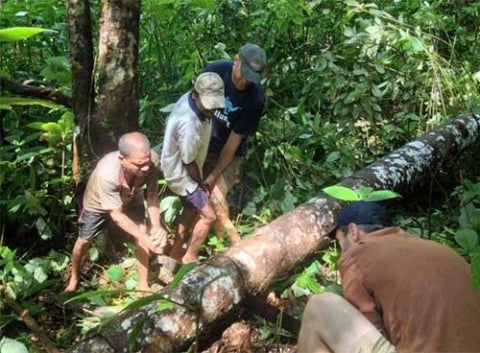 The crew tries to prevent the saw blade from pinching while they cut <em>kitul</em> logs to length.
The crew tries to prevent the saw blade from pinching while they cut <em>kitul</em> logs to length.
Somaratne and Tillekaratne located several older kitul palms on the property and together we set about felling them. These trees had already flowered and were in various stages of mortality. The first tree was very large and was felled with a two-man cross-cut saw. After releasing this tree from the stump, it fell directly into another large tree and a tangle of vines and branches — not the desired outcome. Our friends, however, were not phased — Tillekaratne promptly grabbed his axe and climbed the tree ours had fallen into. At this point, concerned for his safety, we tried all manner of communication (mostly non-verbal) to get him to come down to safety. He and Somaratne expressed a total lack of concern, and we eventually calmed down and let them proceed with their work. Swinging the axe with one arm and hanging on with the other, he deftly freed the kitul palm while managing to stay in the other tree... not something a forester sees every day in the woods!
Once we were all back on the ground, we bucked the palm into the lengths we needed with the cross-cut saw (about 8’) and Tillekaratne made a series of splits with the axe running the length of each segment. The core of a kitul palm is a wet, sweet-smelling pith: very soft and mushy. The outer wood, however, is extremely hard and rot resistant. With the fissures in place, Tillekaratne would twist his axe 90 degrees (something that would break the thin strip of wood through the eye of the axes we’re familiar with in the States) while we jabbed and pried with the digging bar and poles, eventually splitting the 8’ segments into a several boards. The final step was to chop away the mushy pith with a mattock and Viola! We had twenty finished boards. These boards were hauled through the forest down to the nearby river, bound together by vines, and floated back to our nursery. Every part of this process was hard work, but our reward was valuable rot-resistant wood and a fascinating cultural learning experience. We turned two more palms into boards over those couple of days (with all five of us working) and that gave us enough lumber for our nursery beds and new stairs to the field station.
 The river was relatively high while the team made boards, so they were able to float the boards back to the nursery in bundles.
The river was relatively high while the team made boards, so they were able to float the boards back to the nursery in bundles.
Several weeks later, we devised another small project for which we went “shopping.” We wanted to bring the overflow water from the field station’s water tank down to our nursery, so we could easily fill our watering can. For this, Tillekaratne suggested we use some of the larger bamboo growing along the riverbank. These seem to be clumping bamboo varieties, with a diameter of 4 to 6 inches and a height in excess of 40 feet. Similar to the kitul wood, we split the canes of bamboo with an axe and pihiya (small hooked knife) and twisted ninety-degrees with the tool to split the stems along a line. In this case, we didn’t need more than two splits per cane, as we wanted to end up with open-faced irrigation “pipes.” Next, the solid nodes of each half of the cane were chipped out with the backside of the pihiya blade. Within minutes we had several 20-plus-foot water pipes — much easier than preparing the kitul wood!
Creating lumber out of trees from the land we live on is a first for me. In my work as a forester, I’ve decided which trees will be cut and sent to a mill. However, I’ve never cut those same trees, and I’ve almost certainly never purchased the products that those same trees are used to create. Here in Pitikele, we’ve taken this task through to completion — from selecting trees to processing them to their final use in our nursery — much more satisfying than a trip to Home Depot.
Dec. 15, 2016
By Blair Rynearson
With our bodies still aching from construction of the plant nursery — a result of hauling wood, sand and topsoil down hills and through rivers — it was time to visit our neighborhood home gardens. In order to facilitate communication we contacted a local woman, Chamillee, who had served as a translator for previous Yale F&ES students. Her English is a result of conversing with foreign tourists visiting an ecolodge owned by her father. Although our Sinhala is improving by the day, it is very helpful to have someone that can elevate conversations above our limited vocabulary.
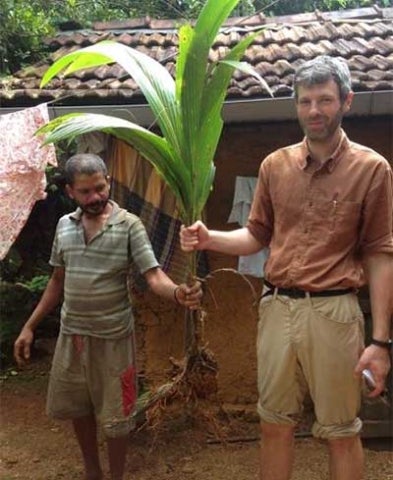 Logan happily receives a young coconut.
Logan happily receives a young coconut.
Chamillee introduced us to families in the towns of Kudawa (25- to 50-minute walk down the road) and Pitakele (5 to 25 minutes down the same road), and explained that we wanted to learn more about their gardens. Further explaining that we were planning to create our own traditional home garden at the research station, she opened the door for a meaningful relationship to develop between the villagers and ourselves. She told them that we were hoping to learn about the species they plant, what they are used for, and how they are grown.
We have found the Sinhalese people to be unfailingly friendly. When they learned that we were interested in how their gardens were planted and managed, this trait was amplified. They volunteered hours of their time, walking us through their properties, fielding our questions and offering us tea and produce from their backyards. We would point to a tree with fruit, and they would tell us the name, how it was planted, and give us some fruit to try (it’s a tough job, but somebody has to do it). We were then instructed to save the seeds, and were given specific instructions on how to plant them.
They told us about various plants used in Ayurvedic medicine for snake bites, healing bones, indigestion, stomach bugs, headaches, eye problems, infections, and the list goes on. Within 50 yards of their house is a well-stocked pharmacy! Interspersed with the medicine is a complete spice cabinet: turmeric, ginger, cardamom, black pepper, vanilla, chili, garlic and more. And let’s not forget the produce department: yams, sweet potatoes, squash, cucumbers, manioc, beans, various types of curry plants, and salad leaves of a greater diversity than I have seen at any American farmer’s market. Fruits are plentiful: coconut, mango, avocado, guava, soursop, custard apple, mangosteen, rambutan, jakfruit, breadfruit, lemon, lime, papaya, and more! To top it all off, they have their own lumber yard. There are abundant timber species, mostly native, with some well-known exotics like mahogany and teak.
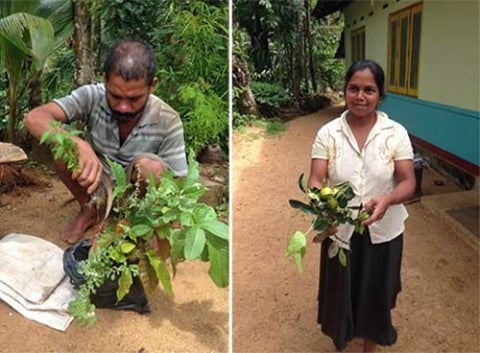 Tilakareatne, left, stuffs a bag with plants transplanted from his garden to the Yale team’s nursery. A Pitakele resident offers bitter mandarins as a seed source.<br />
Tilakareatne, left, stuffs a bag with plants transplanted from his garden to the Yale team’s nursery. A Pitakele resident offers bitter mandarins as a seed source.<br />
We are impressed to find that your average villager can identify hundreds of plant species, their various uses, and how they are grown. Most everyone, it would seem, is a storehouse of intrinsic knowledge. It’s daunting to think that our task is to recreate a traditional home garden designed by what we perceive to be highly specialized horticulturalists and landscape architects. There is much work to be done on trying to learn why, where, and how to plant the hundreds of species that we will collect. It has become apparent that eight months is too short a time to scratch the surface of understanding the complexity of Sinharaja area home gardens… but try, we will.
Thankfully, the local gardeners are more than happy to support us. They fill our bags with seeds, clippings and bare root seedlings of species that they insist must be included in any self-respecting home garden. Logan started asking farmers about their favorite plants, which led to discovering what some villagers find to be their most useful or unusual varieties of common plants. After a mere three days of visiting home gardens, we’ve planted close to forty species in our fledgling nursery!
UPDATE, Dec. 22, 2016:
After more than three weeks of visiting home gardens, our collection of plants is starting to resemble a proper nursery. We have amassed between four and five hundred individual plants, of more than eighty species. As the tropical conditions of Sinharaja are forgiving, the survival rate of our plantings is shockingly high. Most samples are collected as bare root seedlings or cuttings that are somewhat crudely placed in polybags filled with a mixture of organic topsoil and sand. We have followed the lead of knowledgeable locals and used no root hormone or inorganic fertilizer. The only time we water the plants is when it doesn’t rain, which seems to be an infrequent occurrence!
The largest casualty incurred thus far was the result of a friendly visit by a neighboring pack of wild boar. They did a number on our coconut, banana and tubers, but security measures have been stepped up and future incursions seem unlikely (more information to come in an upcoming blog).
We have replicate plants of many of the most essential home garden species and continue to acquire interesting and new varieties of plants. With every visit we are learning more about what should be planted first, and are getting a feel for ideal site conditions for individual species.
UPDATE, Jan. 7, 2017 (by Laura Luttrell):
As of January 7, we have visited and collected plants at 47 local homegardens! In order to facilitate communication we employed a small number of local friends with varying degrees of English speaking ability throughout this time. It has been very helpful to have someone along that can translate our meanings and ease the flow of conversations, but it is also exciting that our Sinhala has now improved to the point that we are able to ask many of the questions ourselves (although that’s not to say that we understand all the responses)!
 Nursery beds slowly filling with plants.
Nursery beds slowly filling with plants.
After so many interviews in the community and a lot of additional hard work with the plants, our nursery is starting to look impressive. We have amassed over 750 individual plants, and over 170 species, including what we perceive to be the core species of most homegardens and many, many, pretty flowers! Beyond the core species, we have been collecting many interesting and special plants from villagers. Having gathered some of the more unusual species from each family we visit has led to us possibly having the most diverse collection of all! The survival rate of our seedlings has been surprisingly high, mostly we think because the climate here is so perfect for growing tropical plants, but lately, we’d noticed that our seedlings were struggling to adjust to the intense afternoon sun. To give them a break, we installed shade netting over one part of the high fenced area and started moving the seedlings that needed more shade. In addition to the seedlings, we have planted 263 polybags with seeds and many of those have germinated, so our nursery is steadily expanding. Next on the agenda is to figure out where to put all these plants! We’ve been talking with villagers about appropriate spacing and growing requirements for many of the plants. Already, we’ve planted a few species directly into the ground, as they weren’t going to make it in a little polybag... (note the large bananas in the fenced area). We also already have a few epiphytes on trees, pineapples out back, and a few flowers along the path.
Dec. 21, 2016
By Logan Sander
This past week saw several new developments in our nursery. While the three of us were traveling we received disturbing news from Somaratne and Dr. Singhakumara: wild boars (ura) had ransacked our nursery, eating our banana, coconut and taro seedlings! The true extent of the damage wasn’t as bad as we had feared, and upon our return we were able to salvage several of the plants. Still, this meant we would need to take measures to counteract what had been our chief anxiety about the nursery to this point: wild animals. Coincidentally, the evening we received this news Laura and I had just visited the National Museum in Colombo and its fine exhibit on traditional agriculture and livelihoods. Aside from the obvious solution of fencing in our nursery, we saw a working model of a non-physical deterrent: a “water-ghost.”
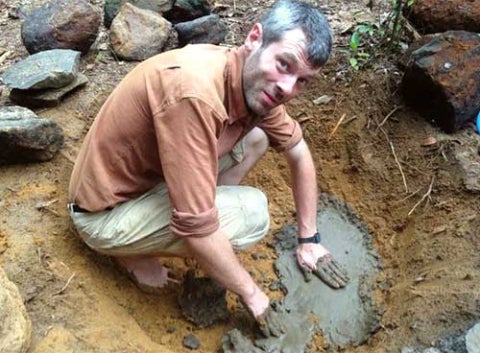 Logan applies river clay to create a small pond.
Logan applies river clay to create a small pond.
The exhibit said that farmers had often used these “water-ghosts” whenever pest animals were eating or destroying crops. To operate, water pours into a piece of bamboo “pipe” until the bamboo’s chambers are filled, at which point its center of gravity shifts and the bamboo swivels downward, dumping its water onto the ground. With this, the center of gravity suddenly shifts again and the bamboo pipe swivels back, rapidly striking a rock. A half-coconut shell is loosely attached to the striking end of the bamboo, amplifying the sound on impact. This sound is supposed to startle and unsettle approaching animals. It’s unclear to me if this would be effective on wild boar, but in addition to building a fence it seemed like a fine opportunity to try out and demonstrate a traditional technology in our homegarden.
With Tillekaratne and Somaratne's help the water-ghost took all of an hour to construct. We piped water from our water tank’s overflow (with our newly- made bamboo pipes) down to our nursery and into the water ghost. Success! Every 4.5 seconds the gentle sounds of birds and insects in our little valley are punctuated with a low-pitched popping sound something like a whiffleball being struck by a hollow bat - audible from a distance (including the field station) but not at all unpleasant (so far...). Hopefully we read the right placard at the National Museum and this isn’t actually a wild elephant call!
We chose to divert the stream of water flowing from the water-ghost into a small pond we constructed. We have been having trouble with our water system when we needed to water our plants; the rapid shifts in pressure when we open and close the valve on our water line tends to separate the plastic pipe somewhere up-valley. This can be incredibly inconvenient, as the water pipe is occasionally strung 20 feet above the river! The pond allows us to dip our watering can and avoid the use of the spigot and this dilemma altogether. We conveniently found a deep, pure clay deposit right at the edge of the river where we bathe. We used a few shovel- scoops of the clay to line a hole we dug and built up with rocks and then connected our new piping to fill the pond. So far, the seal appears to be nearly perfect – even with inflow turned off we don’t lose water out of the pond!
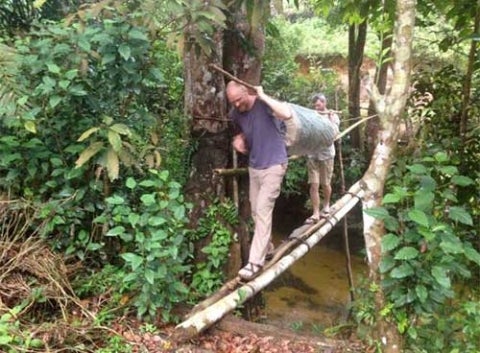 Bringing chain-link fencing from the road to the field station.
Bringing chain-link fencing from the road to the field station.
Our other animal deterrent project was to build a fence. This was fairly straightforward: cut and bury posts, nail stringers between the posts and unroll and hang metal fencing. Most of the wood cut for the fence was from small, short-lived early-successional trees. We enclosed one section of the garden with 5-inch chain-link fencing; another with 3-inch chicken wire; and the final section left unfenced. The plants we know boars and other animals (mostly goona, or wild deer) like to eat go in the tall, chain-link fence. The other plants that show evidence of browsing (apparently from smaller animals) go in the shorter fence. Germinating seeds and unpalatable plants are thus far unfenced. To us this seems like an economical and reliable method of making sure our nursery receives minimal damage from the local wildlife. Of course, an elephant would see our fencing as a feeding trough, but elephants are relatively rare in this valley. Locals report that there are two elephants that occasionally come here, but at intervals of a few years... We’ll keep our fingers crossed that we can have the homegarden planted out and established by the time they make the rounds again. Five days later and our nursery is much more secure (actually, a little prison-like), and just a little bit noisier…
p.s. It has been brought to our attention by a local researcher that our pond closely resembles a wild boar wallow. Expect updates as to our countermeasures’ efficacy...
Jan. 27, 2017
By Blair Rynearson
Before coming to Sri Lanka I knew betel only by description. Friends that had travelled in Southeast Asia told of a nut that was chewed by locals that produced the same effect as smoking cigarettes or chewing tobacco. They said users spit a red juice that looked like blood, and many streets and sidewalks were splattered and stained. Naturally, I wanted to try it.
Sri Lanka afforded that opportunity. Within the first week of arriving at the research station, one of our neighbors offered up “bita.” It was a mixture of a hard, pinkish chunk (very difficult to chew), a large and spicy leaf, a white paste resembling plaster, and a small piece of air cured tobacco. I did not enjoy the texture, or the flavor, or my mouth immediately filling with watery saliva. But the effect was quite agreeable — I was alert, full of energy, and ready to do something.
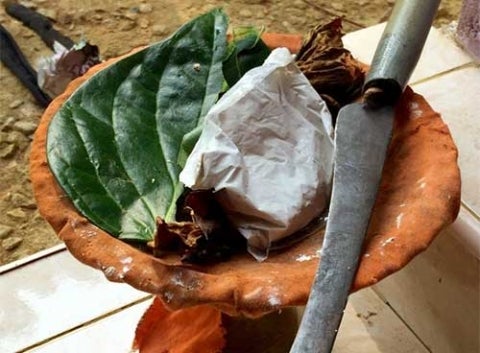 Bulat heppawa with leaves, tobacco, carbonate, and areca nut.
Bulat heppawa with leaves, tobacco, carbonate, and areca nut.
In Pitakele, most men, and a number of the older women, spend the better part of their waking hours chewing bita. A small plastic bag full of bulat leaves (Piper betle), puwak (Areca catechu), tobacco and calcium carbonate, is carried at all times. This ensures that chews are continually refreshed throughout the day. In addition to it’s stimulant properties, bita serves as an appetite suppressant and helps stave off thirst. This allows users to forgo lunch and dedicate themselves entirely to the labor at hand.
In traditional preparation of bita, the areca nut (which is in fact a palm fruit and not a nut) is the most active ingredient. It contains three alkaloids — arecoline, arecaidine and guvacine — all of which posses vasoconstrictive properties. The betel leaf, or “bulat,” is largely added for its spicy flavor, but also contains eugenol, an additional vasoconstrictor. The calcium carbonate, typically derived from ground sea shells or coral, heightens the effect of the stimulants. Spices are occasionally used to add flavor to the mixture and might include: turmeric, cumin, melon and cucumber seed, tamarind juice, coriander, nutmeg, ginger, cardamom, cinnamon, cloves and grated copra. Sun dried tobacco leaves have become a normal addition to bita.
Adding nicotine has both increased the stimulative properties and addictive effects. Bita mixture that includes tobacco and calcium carbonate has been proven to cause dental caries, oral sepsis, dyspepsia, palpitations, neurosis and oral cancer. And the red juice produced by the chemical reaction with the calcium carbonate often dyes a user’s lips red, and gives the teeth a reddish to black appearance (this is the only reason that I choose not to make bita an everyday habit).
 Two puaks enjoy the sunshine; notice the fruit just below the canopy of the right palm.
Two puaks enjoy the sunshine; notice the fruit just below the canopy of the right palm.
In Sri Lanka, betel leaf, or “bulat” is among the most culturally significant plants. It was customary upon receiving a guest at your home to present them with a “bulat heppuwa,” a brass tray filled with ingredients used in bita preparation. Before a meal guests were offered a glass of water to wash out their mouths, and after the meal a replenished tray of bulat was presented. Virtually every home had both a “padikkama,” a spittoon, and specialized areca nut cutters. Formal greetings often involved the presentation of a sheath of bulat leaves called a “bulat atha.” Athas are presented by patients to traditional doctors as a form of payment, by children to their teachers on the first day of school, and by devotees to chief Buddhist monks during temple visits. Bulat continues to play a central ceremonial role in weddings, funerals and many holidays.
The bulat plant is an evergreen, perennial climber typically cultivated on poles or trellises. There are at least twelve varieties of bulat leaves native to Sri Lanka. It can be grown up to 1,000 meters in elevation on all soil types, but typically grows best on well drained soils, at lower elevations, in the wet to intermediate zones of the country. Though it is most productive in full sunlight, bulat produces higher quality leaves when grown under shady conditions.
Many homes in Pitakele village are adorned with wooden structures that are thickly covered in an intertwined mass of bulat leaves. Another common planting site is the base of trees and palms, the trunks providing a live post to support the climbing bulat. Bulat leaves are sold in two categories: large leaves for two rupees (just over a cent), and small leaves for one rupee (less than one cent). They are cut, carried to the house, graded by class, and taken to a nearby town to be sold.
Areca, or “puwak” as it called in Sri Lanka, is among the most ubiquitous and abundant species in Pitakele tree gardens. It grows best in full sunlight, but is proficient in establishing and growing under the shade of the canopy. As a result, many homegardens with minimal management tend to develop dense stands of puwak. It is often found planted along property lines as a living demarcation of lots.
The fruits are consumed locally or sold, and the “wood” is highly durable and used in construction, fencing and garden stakes. On sunny days, most Pitakele residents spread piles of puwak over rice bags and wicker trays for drying. The nuts are generally harvested from fallen fruits on the ground, or cut from the palm. To prevent molding, they are laid in the sun and stored in a breathable sack. Following the initial phase of drying the outer husk is removed. Dried and husked areca nut is sold for five hundred rupees per kilo.
Although it is unlikely that many of the academics or students that spend time at the research station will frequently indulge in bita, we chose to include both puwak and bulat into the design of the homegarden. If a goal of the project is creating a homegarden that embodies local traditions, these plants are indispensable. During our many visits to Sinharaja gardens, we asked local residents about the most important species to plant at the research station — in almost every response, bulat made the short list. And I know that our cook/housekeeper and neighbors will ensure that they are well tended and do not go to waste!
Feb. 26, 2017
By Logan Sander
We are here in Pitikele village trying to plant a “traditional” homegarden, but in many ways how we’re going about that is as foreign as we are. I believe our homegarden will be what we hope it to be (i.e. diverse, representative, productive, beautiful, and educational), but it won’t be traditional in the sense that it came about the way that other homegardens in Pitikele do. I’ll explain why this isn’t a problem and try to make clear our approach to designing and creating a homegarden.
Obviously, we’re neither from Pitikele, nor do we have a great depth of personal experience with the types of plants we’re growing (I’m from Alaska, Laura is from Virginia, and Blair is from Washington State). As a result, we’ve been forced to adopt a somewhat novel approach to our homegarden. When a person in Pitikele plants a homegarden, it’s a long-term, highly iterative and experimental process. Instead of up-front planning, I believe “traditional” homegardens arise out of patterns observed in countless neighboring homegardens, skills learned early in life through helping and watching in the family garden, and through a personal (and somewhat variable) understanding of the requirements of each plant. We’ve had peeks into this process by observing Someratane and Tillekaratne’s work on their own gardens, and my impression is that folks opportunistically gather plants they desire to grow and plant them where it makes sense to them — gradually, over a period of time that spans generations. And it works — beautiful gardens develop with no maps, no deadlines, no external labor to organize, no design principles, no grand plans. Since we don’t have these experiences to draw from, and we’re trying to get this garden up and running in a year or so, our approach is necessarily more cerebral, planned and abbreviated. We’re hoping the end result is recognizable to local folks as a homegarden (we think it will be!).
Our approach to designing this garden borrowed heavily from our experiences with permaculture design, professional forestry and our gardening experience. In permaculture design, a space is divided into “zones” that reflect the management needs and priorities of a place. For example, “Zone 1” includes those areas around a home where the manager/occupant is most likely to interact, i.e. the walkway from the car to the front door, the area around the patio, the planter box outside the kitchen window, and so forth. This is where one would concentrate those things that have frequent management needs (watering, weeding) and produce frequent yields where convenience is a key attribute (culinary herbs, medicinal plants). The complete schema is as follows (adapted to our context):
-
Zone 1: near the house, frequent maintenance and/or yields, enjoyable aesthetics, access is most important; e.g. culinary herbs, frequently used medicinal plants, flowers, plants that need to be grown near the home.
-
Zone 2: moderate maintenance needs; e.g. vegetable crops, fruit and nut trees, medicinal plants, perennial crops.
-
Zone 3: low-maintenance, more extensive tall-tree orchards, and timber trees.
-
Zone 4: e.g. woodlot, natural forest management.
-
Zone 5: “wilderness,” or at least, unmanaged areas.
Because there are three of us designing our homegarden, we thought the concept of zones would help us to divide the work so we wouldn’t need to “design by committee.” This way, with constant consultation and feedback, we could each focus on our own design problems, keeping in mind that the relationships between our designs were as important as anything else. Laura would tackle Zone 1 around the home, I would take on the surrounding Zone 2 fruit trees, and Blair would handle what we call Zone 3, the outlying tree gardens of coconuts, jak fruit and other tall, widely-spaced trees.
It doesn’t take long to realize that traditional homegardens blur many of the boundaries between these zones, though I believe the categories are useful. We observe at every homegarden a zone around the dwelling that has potted plants, ornamental flowers, medicinals, and everyday food plants. This high species diversity, low-abundance region has been called the “patio” in Sri Lankan research articles, and it corresponds precisely with the Zone 1 definitions of most permaculture designers. Zone 2 is not quite as tidy, but we’ve still recognized a rather tight ring of fruit, nut and timber trees around the home that neatly corresponds to Zone 2. Zone 3 is overall looser, as Zone 2 tends to cut into and between areas of Zone 3.
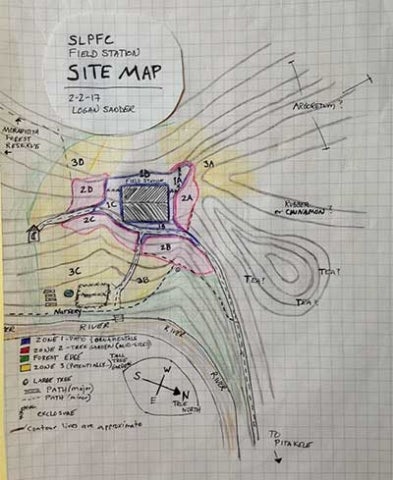 The Sri Lanka Program for Forest Conservation Field Station and the zones of cultivation for the homegarden.
The Sri Lanka Program for Forest Conservation Field Station and the zones of cultivation for the homegarden.
It’s important to remember that these categories are merely social, behavioral distinctions; nothing will be permanently marked off to show them in our garden. Instead, the evolving patterns of use and maintenance, combined with plant structure and development, will mean that these zones are continually redefined. They are really categories of the behaviors of the people managing the garden, as expressed through their priorities and habits.
We further informed our design process by conducting a site analysis, much as a forester would do when writing a management plan for a family forest. We mapped out the existing vegetation that we wanted to retain, the design constraints (e.g. views, powerlines, buried pipes), basic hydrological attributes, soils, the path of the sun, and access opportunities across the homegarden. Based on historic photos and our soil pits we were able to reconstruct the recent history of the homegarden area, recognizing some areas of relatively rich topsoil and several areas of redistributed subsoil fill. From this, the three of us put on our boots and spent a day flagging out our zone delineations. Next, we planned which species should go where. In order to determine this, we relied on our observations, our conversations with local gardeners about our specific plans, our knowledge of the site requirements of each plant, and the built in limitations (e.g. view shed, house proximity, powerlines, floodplains).
We split up each zone into smaller parcels in order to organize our work and have something to refer to when planning. Each parcel can be identified by a number (zone) and letter. We’ve included Laura’s and my maps of zones 1 and 2 here. After discussions with our local colleagues at the Universities of Sri Jayewardenapura, Uva Wellassa, and Peradeniya, and those at Yale, we’ve decided to plant out a more modest area this spring, saving the remainder for upcoming fellows. Part of the reason for this is time — we can do our site preparation now while it’s dry, but most of our planting must happen during the rainy season. We all have to leave for home in June, and the southwest monsoon generally begins in May, leaving us a short amount of time to wrap things up and get plants in the ground. Also, much of the soil we’re working with (especially in zone 2) is sandy-gravely subsoil that was pushed around during the groundwork for the field station. It is extremely low in nutrients, droughty and low in organic content. We don’t know how our plants will do in these areas, so it makes sense to only plant out part of our nursery in the hopes that we can learn something in the meantime about their success and adjust our planting/site preparation accordingly… sort of like, not putting all of our eggs in one basket... As a result, before we leave this summer we hope to plant all of zone 1, parcels 2B and 2C, and whatever areas of zone 3 we can manage.
The included maps are only a first iteration. Since we created these maps, we’ve already made many changes and as we visit other homegardens (we’ve been to over 50 so far!), botanical gardens (the Peradeniya Botanic Garden in Kandy is incredible), and receive more feedback, other changes will surely be made. Many more trees, shrubs and herbs will eventually fill out the space after these species are planted — some will be planted by us as we observe and learn and more will be planted in the future as more fellows continue our work. It’s fun to imagine what this place will look like in 5 to 10 years!
March 4, 2017
By Logan Sander
We’ve made several significant improvements to the field station’s land since our last update. Key among them — we’ve begun planting out specimens from our nursery!
Faced with burgeoning stocks of plants that were rapidly outgrowing their polybags (mostly ornamental flowers and edible bean crops we grew from seeds), we decided that we needed to find a space to grow them to maturity. We still haven’t completed our designs for the overall homegarden, but these are mostly plants that grow rapidly, can grow near the house (on land already cleared) and can potentially offer yields before we leave our posts here.
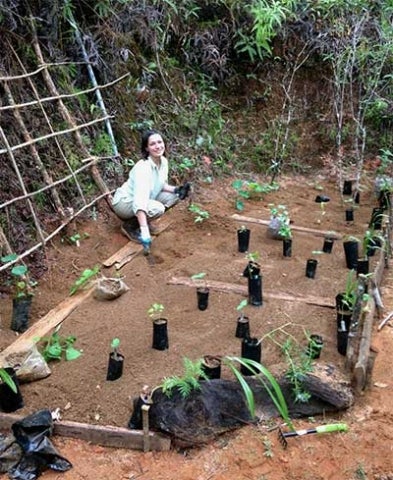 Laura arranges the potted flowers for planting in the garden.
Laura arranges the potted flowers for planting in the garden.
The soils immediately surrounding the field station are infertile, droughty sands and “rotten” bedrock that was exposed during the initial excavations. Before the field station was constructed, these soils would have been several meters below grade — in the humid tropics, this usually means they are extremely low in nutrients. Still, several opportunities presented themselves — the site was flat, easy to access (literally, right out the door), and relatively rich topsoil in abundance 20 meters away in the fallowed fernland. We marked off an area and got to work.
Our “garden” is about 4-by-6 meters in extent, up against the escarpment that was excavated around the field station. We built a perimeter wall by staking in
kitul palm boards and filled the area 6 inches deep with topsoil (
kalu pas, or “black soil”). Against the escarpment, we built wooden trellises of a tree species that may root and continue to grow, creating a living structure on which to grow climbing beans. We needed to protect this area from wild boars, as much of what we hope to plant is the boar’s favored food (as we’ve already learned in the nursery…). On one side this was already taken care of: the escarpments leading to the field station are likely too steep for boar to descend (we hope…). On the other sides we simply extended the walls of the field station with 1m-high fences, creating a narrow protected zone around the field station.
Into our over-sized garden bed we planted an assortment of plants gathered from Pitikele’s homegardens — mostly early-successional food plants with relatively short-life cycles. Interestingly, many of these plants are “annuals” in temperate areas, while in the tropics they can live many years as perennials. In addition to the following species, we intend to plant manioc, a few bananas, and other food plants that require defending from the wild boars.
Homegarden plants of the “patio’s” initial planting (
Sinhala name; English name;
scientific name):
-
kiri ala (taro, Colocasia esculenta)
-
demas ala (coco yam, Xanthosoma sagittifolium)
-
makeral (climbing bean)
-
cowpi (black-eyed pea)
-
bonchi (climbing bean)
-
dambala (winged bean, Psophocarpus tetragonolous)
-
das mal (marigold, Tagetes erecta)
-
gas lunu (ornamental flower)
-
battala (sweet potato, Ipomoea batatas)
-
begonia (Begonia spp.)
-
gota kola (Centella asiatica)
-
gam miris (black pepper, Piper nigrum)
-
goda manil (ornamental flower)
-
Japan rose (ornamental flower)
-
kudelo mal (Impatiens spp.)
-
akapana (Kalanchoe pinnata)
-
miris (chili pepper, Capsicum spp.)
-
takkali (tomato, Lycopersicon esculentum)
-
tibbatu (Solanum violaceum)
-
parabombatu (Solanum spp.)
-
singhamoku (snapdragon)
This protected gardening area provides several opportunities for us to improve our homegarden project. As already mentioned, we can create long-term planting sites for those plants that require protecting. Also, this gardening site’s proximity to the field station makes it valuable for higher maintenance plants. This includes those in need of frequent watering (believe it or not, we just had over three-weeks with no appreciable rainfall) or harvest. Additionally, and perhaps most importantly, growing plants right outside our door gives us the opportunity to observe and learn from them before we greatly expand the project.
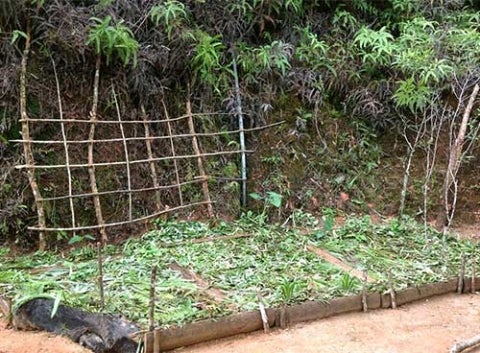 The planting beds filled with top soil and full of newly planted flowers with a wooden trellis to encourage climbers arranged at the back adjacent to the cut bank.
The planting beds filled with top soil and full of newly planted flowers with a wooden trellis to encourage climbers arranged at the back adjacent to the cut bank.
In fact, just one day after we planted this garden bed, I observed that a kudelo mal (Impatiens spp.) plant had several leaves curled up or chewed apart. This morning, I noticed that all the leaves on plant were either consumed or curled up. Fine silky webs sprinkled with copious amounts insect larvae frass (aka poop) encircled the few remaining leaves. As I inspected the plant, Tillekaratna walked up and explained that the problems were a result of “worms.” He pulled apart one of the leaves and out popped a wriggling green caterpillar. As we’ve been told many times before, we needed to apply ash to these plants to prevent worms. Lesson learned!
This is one of the more satisfying developments in our project to date. Our frequent admiration and inspection of the garden ensures that it will be watered, every inch of ground will remain mulched and any destructive factors will be promptly mitigated. This garden bed benefits both from its proximity to our dwelling (and the aforementioned benefits this entails) and its novelty as our first significant planting effort. Soon we will greatly expand our plantings and our responsibilities will multiply. Until then these few lucky plants are the show’s main attraction.
March 7, 2017
By Laura Luttrell
As our language has improved, so has our immersion into the community. We’ve had several experiences that we don’t fully comprehend, but have been happy to come away with the small extent we understand and the education and enjoyment of engaging with the people around us.
Here are a few examples of cultural engagement, as well as some fun tidbits of our time here…
 Teams of children race at their school’s annual parade.
Teams of children race at their school’s annual parade.
Once a year, the elementary school in town holds what we think of as a “field day.” It includes races, singing, a building competition, and other activities. We decided this would be interesting, so we attended, along with much of the community. The parents of the children build the houses the night before and are judged partly based on their inclusion of traditional techniques and representative traditional practices (like the way the rooms are set up and the tools they include in the kitchen). The houses were impressive. One team built a house-like house, another built a peacock house, and the third built an elephant house. We loved seeing the palms, bamboo, and bananas used to make these structures. The children were also impressive and quite cute!
One day a carpenter friend of Tillekaratne and Someratne’s came by the field station to hang out. We got to talking and showed him a photo of the tiny house we built. He was so impressed! He loved it and wanted a copy of the photo. He also invited us to his house to meet his family and have dinner with them. They made us a delicious feast of jak fruit curry, gota kola (a foraged green) and coconut salad, fruit, and of course pre-dinner sweets and tea. They showed us some of the things that Nanda Pala has made, including their house, furniture, and some cool bamboo cups. Logan hopes to go back and make bamboo cups with him one day. His mother-in-law also showed us a beautiful old traditional basket.
Another day our researcher friend, Champika, brought us wild bananas that he found in the forest. They were more seed than flesh! Who knew? The flavor was good, but spitting out that many seeds was quite the chore… I can see why we favored eliminating them.
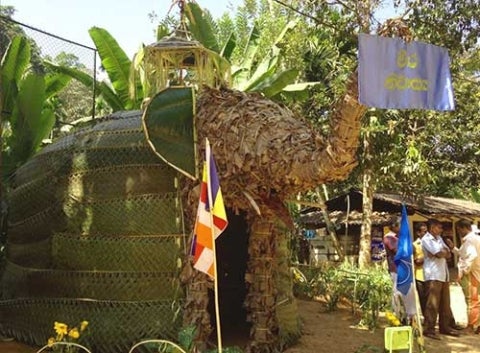 An elephant house made from palms, bamboo, and banana.
An elephant house made from palms, bamboo, and banana.
In an attempt to share our culture, Logan and I decided to make a pasta dinner for Someratne and Tillekaratne. To appeal to their taste, we went for an arrabiata-like sauce, adding a good number of little chilis. We had some Italian seasonings that my sister had brought us when she visited and added lots of garlic and onions. We also made garlic bread. It was delicious! They seemed to think so too… at least that’s what they led us to believe!
A few days ago, we found two lizards hanging out in the field station. One of them left later that day, but the other took up camp on top of our bug net! After the first night, we decided maybe he would like to be our pet, so we started feeding him bugs that we found around. So far, we have given her a couple of cockroaches and a beetle. She’s been here for three nights! I’m sure one day, she’ll choose to move on, but for now, her life seems pretty cush.
I think I’ve written before that I really like drinking the water from coconuts… Since they grow all around here, we asked Tillekaratne if he could find us some to buy.
Shortly thereafter, he took us to his uncle’s house where he proceeded to climb a giant king coconut tree and cut us down 20 coconuts. He put those on the tea truck that would deliver them up the hill that afternoon along with several sprouted coconut seedlings, so we could grow our own.
Below is a video of Tillekaratne climbing the coconut tree. It took him a while to cut out the coconuts, so that part isn’t in the video. Still, check out those climbing skills!
March 8, 2017
By Laura Luttrell
Having past the halfway point of our stay in Sri Lanka, we realized that we have yet to visit very much of the country and so, we’ve made it a point to start seeing some of the highlights. This blog recounts a number of our trips in February and March to mountains and hills of central Sri Lanka.
The train ride from Kandy to Ella is supposed to be one of the most beautiful ways to see the countryside, so back in December, we were going near Ella for a meeting and decided to take the train there from Colombo. It was a great trip (much more relaxing than a bus) and truly — the scenery was gorgeous! The environment and climate changed dramatically as we climbed into the agricultural region of the hill country and even through a pine forest along the way. In Ella, we climbed Ella Rock (about a 4-hour round-trip) for a birds-eye view of our surroundings and a smaller mountain called Little Adam’s Peak (maybe two hours). We also took a bus out to see Ravenna Falls, where we met up with at least 100 other people admiring it.
 Laura and Logan at Bakers Falls, located in Horton Plains National Park.
Laura and Logan at Bakers Falls, located in Horton Plains National Park.
At the end of February, we took a trip up to Kandy. It is in the center of the country and often spoken of as the cultural capital of Sri Lanka. Kandy was the site of the final kingdom of the country, holding out against the British until about 1815. Our quick trip there was dominated by a much too short (three hours) trip to the Royal Botanical Garden in Peradeniya. It dates back to the ancient kings of the country. In 1821 Alexander Moon, designed the garden as we see it today when the British took over. We were amazed by the diversity and beauty of the collections. We hope we will get to go back!
From Kandy, we went on to Nuwara Eliya. Due to its cool climate in the hill country of Sri Lanka, it has been given the nickname “Little England.” This area is known for its terraces of potatoes, carrots, leeks, and especially for its high country tea (some of the world’s finest Orange Pekoe).
We visited a tea factory (which will be covered in a blog about tea!) and spent a day at Horton Plains National Park. At an average starting elevation of 7,500 feet (2,300 meters), Horton Plains is the most extensive area of cloud forest and montane grassland still existing in Sri Lanka and its cooler climate made for very enjoyable hiking. We first walked the well-trodden 9.5-kilometer loop that includes the “Worlds End” (both a mini one and a greater one) and a large waterfall, called Baker’s Falls. While the views were impressive, we found this loop a bit crowded and were very pleased with our decision to next climb the nearby mountain, Kirigalpoththa. At close to 800 feet (2,395 meters), Kirigalpoththa is Sri Lanka’s second-tallest mountain (the summit of the tallest is off limits due to TV towers on top). Along this trail, we passed through open grasslands, thick forest patches, rocky outcrops, and along a river. We passed a few groups of Sri Lankan visitors, but their presence in no way deterred from our enjoyment of this excellent backcountry hike. As we neared the top, a gentle rain accompanied us. It didn’t interfere much and as we climbed back down and out of the rain, we could see where the rain clouds were encompassing the peak.
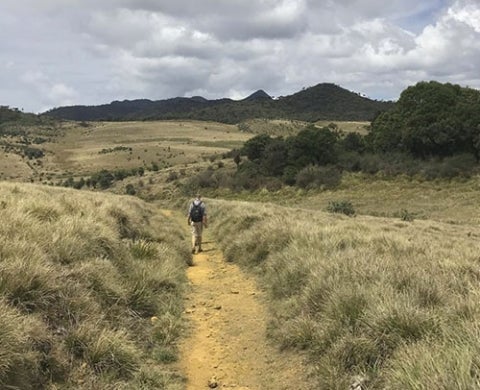 Blair walking the path to Kirigalpoththa.
Blair walking the path to Kirigalpoththa.
Next we travelled west in order to climb the 7,400-foot sacred pilgrimage mountain known variously as Adam’s Peak (where some believe Adam first set foot on earth after falling from heaven), Sri Pada (Sacred Footprint, where Buddha stepped on his way to paradise), or Samanalakande (Butterfly Mountain — where butterflies go to die). There are many other beliefs as well about whose huge “footprint” is at the peak of this mountain, but regardless, over one million people make this journey every year, some out of devotion and others curiosity… probably not just for the exercise though. The 5,200 stairs that comprised the route I took, was a tough journey both up and down, mostly due to the pressure it put on my knees and the 2 a.m. start made for a poor night of sleep and an exhausting rest of the day. Still, the challenge was exciting and the cultural experience was interesting, so I’m glad I got to go. Unfortunately, when we woke up for the climb, Logan was sick, so we postponed a day and then the following day, he was still feeling bad, so I ventured the climb with two women I met from New Zealand instead. He hopes to go back and reach the peak with a few of our Sri Lankan friends from Pitakele in April, but he’ll climb from our side of the mountain — 9,000+ steps!
Before we leave, we plan to also visit the cultural triangle with its many religious sites and the east coast beaches, including the fort city of Trincomalee, so stay tuned as more Sri Lankan adventures are in store. Before that though, we found out that in order to extend our visas, we need to leave the country before we reach six months. We could have just taken a little one day trip to India or the Maldives, but since Logan has always wanted to go hiking in the Himalayas, we thought this would be a great opportunity. So, in just one more week, we’ll be spending three weeks hiking in Nepal (and I assure you — the photos will be stunning!).
 Laura, Logan, Vinh Lang ’15 M.F., and Blair packed into a motorized tricycle called a “tuk tuk.” Lang, who did research at the Sinharaja Forest and for the Sri Lanka Program for Forest Conservation while a student at F&ES, spent time with the group during a brief visit.
Laura, Logan, Vinh Lang ’15 M.F., and Blair packed into a motorized tricycle called a “tuk tuk.” Lang, who did research at the Sinharaja Forest and for the Sri Lanka Program for Forest Conservation while a student at F&ES, spent time with the group during a brief visit.
April 12, 2017
By Blair Rynearson
Virtually every visit to a home in the Sinharaja area involves a cup of tea. The tea is almost always served plain, accompanied by a large, jagged brown block of kitul sugar, or kitul “hakuru.” I don’t have much of a sweet tooth and the thought of eating a large white sugar cube disgusts me. But kitul hakuru is different. It’s prepared by boiling down sap from the kitul palm (Caryota urens), and has woody, smoky and almost savory notes. There are four varieties of hakuru in Sri Lanka: Pol hakuru — made from the sap of the flower of coconut trees (Cocos nucifera), thal hakuru — made from the flower of palmyra trees (Borassus flabellifer), ukk hakuru — made from sugar cane (Saccharum spp), and kitul hakuru. Most Sri Lankan’s acknowledge kitul hakuru as superior, and it is an essential ingredient in many sweets and foods.
Before tea took it’s place as the dominant income stream in the Sinharaja area, most households earned the larger part of their income from production of kitul sugar and rubber. Women were responsible for collecting the rubber, while the men dedicated themselves to tapping kitul palm. The communities surrounding the Sinharaja reserve are nationally renowned for their kitul tappers, men who make their livelihood by climbing kitul palms to harvest the sap from the flowers. It is not an easy way to earn a wage.
 A kitul tapper installing a ladder made from a sapling secured to the kitul by a bandula vine.
A kitul tapper installing a ladder made from a sapling secured to the kitul by a bandula vine.
Aside from a handful of kitul palms planted in local tree gardens, most of the trees are scattered throughout the lowland wet forest. They are typically found in the sub-canopy, located along forest fringes and in gaps. This means that tappers have to walk many miles daily between their home and the location of the trees. To ensure that the flower does not heal over the incisions made for draining the sap, kitul palms must be tapped twice per day. If the flower were to heal over the cut, the flow of sap stops. This means that rain or shine, sick or healthy, the kituls must be climbed and tapped.
Once a mature flowering kitul has been identified, it requires preparation for tapping. The first step is installing the ladder. These ladders generally consist of two large saplings running parallel to the trunk of the palm. At two to three feet intervals, the saplings are secured to the trunk with vines that serve as rungs, most commonly using the stem of a pitcher plant known locally as “bandura” (Nepenthes distallatoria). A mature kitul can reach twenty meters in height and installation of the ladders is time consuming. They are repaired and replaced when the vines dry out and start to crack.
Who gets to tap what tree is something of a mystery. It seems that different families have established territories. These territories existed well before the foundation of the Sinharaja reserve. And up until this year, Sinharaja has respected this tradition, allowing adjacent communities to tap trees in the reserve. I have heard that starting next year the government plans to suspend this right.
Ater the ladder is installed, the flower is prepared for tapping. By flower, I refer to a massive inflorescence that can be up to five meters in length. The first time a kitul flowers it produces the largest inflorescence. Subsequent inflorescences decrease in size until the death of the palm. A kitul palm can produce up to ten flowers in it’s lifetime. Kitul usually starts flowering after about eleven to fifteen years of age and flower about once year until the last flower is produced where upon it dies, usually by age thirty.
To prepare the flower for tapping the rachis are stacked against each other and tightly wrapped together with a vine. Some tappers make a poultice from a mixture of plants purported to stimulate production of sap that is applied before wrapping the flowers. The plant species used in this concoction is a well-kept secret. Once wrapped, the terminus of the inflorescence is situated so that sap will drain into a pot suspended below. These pots are just the right size to collect a half a day worth of sap. Twice a day the tapper then climbs the tree, barefoot and without a harness, retrieves the full pot and puts an empty one in its place. The full pot is then secured around the handle of the sheathed kitul knife, where it dangles as the tapper descends the tree.
The knife used to tap the flower is treated as a sacred tool. It is thin, light and the razor-sharp blade is frequently honed on the branch of a hardwood tree. A tapper friend in the community has repeatedly told us a story involving a university professor using his kitul knife to cut some wire. It occurred some twenty years ago, but the indignation persists. The sharpness of the blade is important for shaving razor thin pieces from the flower. Skilled cutters can prolong the duration of tapping a flower by cutting less.
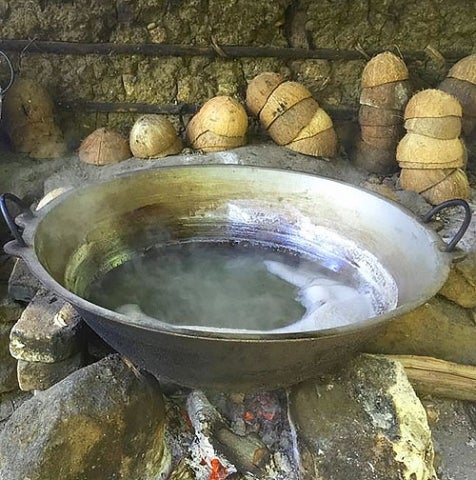 Slowly cooking kitul sap almost ready to become penni.
Slowly cooking kitul sap almost ready to become penni.
Once exposed to the air, the unprocessed kitul sap starts fermentation immediately. If left for 24 hours, it turns into what is referred to as “kitul ra” in Sinhala, or “kitul toddy” in English. If I may inject my opinion into this blog — it’s delicious and somewhat inebriating and definitely to be consumed at the end of a long day! Although production and sale of kitul toddy is illegal, it does occur. But most kitul sap harvested in the Sinharaja area is destined to become sugar. And this requires rapid cessation of fermentation to prevent the wild yeast from consuming the sap’s sugars.
To achieve this, the local people have discovered tree barks that arrest fermentation. The most commonly used species are two dipterocarps, Nawada (Shorea stipularis) and Hal (Vateria copalifera). Bark is stripped from the tree, and the inner layer is peeled and placed into the fermenting kitul ra. Local people say that this harvest of bark is generally non-lethal. Once the fermentation has slowed, the sap is stored until there is sufficient volume to fill a large pot specifically used in the production of kitul sugar. The sap is slowly heated over a fire, which can take more than a day and requires a great deal of firewood (this is what imparts the characteristic smoky flavor).
The first stage of kitul sugar is reducing the watery sap to a thick brown syrup known as penni. Penni is used in many desserts and foods throughout Sri Lanka, the most ubiquitous being “kiri-penni”, creamy buffalo yogurt slathered with kitul syrup. To obtain one liter of penny, you need roughly eight to 10 liters of kitul sap. If penny is not the desired product, cooking is continued until the syrup reduces to a consistency suitable for making hakuru. When ready, it is poured into molds made from half coconut shells and allowed to crystalize. The result is a dome of brown kitul sugar, the unit by which hakuru is typically sold
In the Pitakele area, kitul tapping is a dying tradition. Most of the tappers that remain in the community are men over forty years old. And many other men that formerly tapped trees now devote themselves to planting and harvesting tea, which is an undeniably safer, and more lucrative livelihood. Many people tapping trees now do so primarily for personal consumption of kitul ra, penni and hakuru. What does this mean for Sri Lanka’s future supply of kitul sugar? Unless there’s a dramatic increase in price, supply may dwindle. People will have to start eating their buffalo yogurt with just plain sugar
For further reading see: Zoysa, N.D., 1992. Tapping patterns of the kitul palm (Caryota urens) in the Sinharaja Area, Sri Lanka. Principes, 36 (1), pp.28-33.
April 24, 2017
By Blair Rynearson
Now is time to start planting what is arguably the most important part of any Sri Lankan homegarden — the coconut trees. Sri Lanka has numerous varieties of coconut, and the people consume them frequently, in almost everything. After five months of living and working in Pitakele, I can still use one hand to count the number of times I’ve had a meal without some form of coconut.
There are coconuts for drinking, and coconuts for eating. In Sri Lanka, coconuts for drinking are known as “tambili”, and there are many varieties — at least five are planted in the Pitakele area. Coconuts grown for their meat are equally diverse. There are coconuts that reach more than 60 feet in height, and dwarf coconuts that grow no taller than 10 feet. Our garden will house a mix of both locally grown varieties, and improved varieties procured from agricultural research stations. We will plant a higher than normal load of the drinking variety, as foreign researchers find them to be very refreshing on a hot day.
 Someratna helps in navigating the kekila fern scrubland to locate planting sites for coconuts.
Someratna helps in navigating the kekila fern scrubland to locate planting sites for coconuts.
I assumed that planting coconuts would be the same as any other tree. How wrong I was. Spacing between coconuts needs to account for the sprawling fronds. The Coconut Research Institute of Sri Lanka (CRISL) recommends a spacing of 20 to 25 feet! And the hole excavated for planting a coconut seedling is wildly disproportionate to the size of the root mass. Most seedlings at the time of planting have a root system comprised of the intact coconut, and a few thick roots protruding from the husk. Yet, the CRISL recommends that the young coconut should be planted in a hole no smaller than 4X4X4 feet. That’s almost the size of a grave. It is rare that you don’t run into a few rocks while digging a hole of that breadth. What’s more, planting should occur at the onset of the monsoon. This means that it’s hot and humid. As I dug the holes with my friend and coworker Tilakaratne, I sweat a disgusting amount. Tilakaratne repeatedly asked if I’d been swimming, or whether it was raining, which I didn’t find to be particularly amusing. And the sweat attracted elephant flies (think horseflies on steroids), quite literally turning insult to injury.
But it doesn’t end there. The very same CRISL recommends that you line the base of the pit with two layers of coconut husks. These must be hauled to the holes, in addition to even more coconut husks that will be used as mulch when the planting is finished. So after lining the hole with a layer of husks, followed by dirt, followed by a second layer of husks, you arrive at the point where you can fill the hole with soil.
The CRISL is not happy with just any soil — they recommend mixing topsoil with 10 kg of cattle or goat manure, 1 kilogram of dolomite and 1 kilogram of young palm mixture (two parts urea, three parts saphos phosphate, two parts muriate of potash). Thankfully, things in Sri Lanka are comparatively cheap. I purchased 10 bags of “compost,” each sack weighing 20 kilograms, for a grand total of $23. In this case “compost,” is composted cattle and goat manure mixed with dolomite. All that was missing was the young palm mixture, and I purchased a 20-kilogram sack of a similar product for $10. After the truck dropped the supplies at the base of the foot bridge leading to the research station, we threw the sacks on our shoulders and carried them 200 yards to the house. Following that, we hauled the compost to the planting site, in addition to an equally large sack of topsoil taken from near the forest edge (this is to supplement the poor soils on the kekila fern slopes). At which point we mixed the soil, compost and fertilizer.
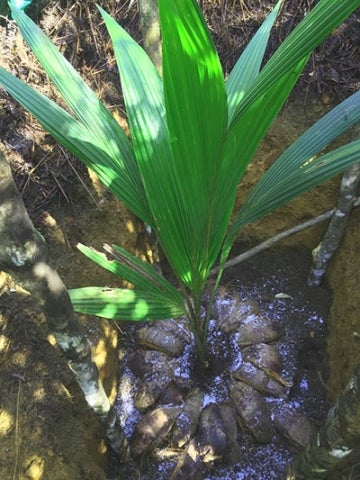 A planted seedling.
A planted seedling.
A small hole was made in the soil mixture and the coconut and nascent root system were buried. To support the seedling, Tilakaratne buttressed it between a tripod of three sticks, secured with a vine that comes from the stem of a species of pitcher plant (Nepenthes distallatoria). Per recommendation of CRISL, coconut husk were placed around the seedling as mulch. This step differs from local tradition — people in the Pitakele area place rocks rather than coconut husks around the seedling. Tilakaratne fears that the husks might attract termites which will attack the seedling. This might have merit, we plan to plant some with rock covering and others with coconut husks as an experiment. The final step of planting involves sprinkling a bag of salt around the tree to discourage attack from termites and black beetles.
But it’s not over. Predation of coconut seedlings by a healthy wild boar population is a common occurrence in the Sinharaja area. The boar are attracted to the nut buried under the ground. They typically uproot the plant and eat the roots, effectively killing the young coconut seedling. To ensure maximum survival, each individual coconut tree requires fencing. This inspired a trip to the forest edge to fell a smallish alstonia tree (Alstonia macrophylla), which will be used for posts. The tree is cut in half, and the small logs hauled to the planted coconut where it is further cut down to the size of fence posts. Four holes are dug with a rock bar, the posts placed, and PVC coated, galvanized chicken strung and nailed. And that’s it. One down out of the twenty coconuts that we intend to put in the ground.
Blair Rynearson grew up in western Washington. He has a BS in ecology from Beloit College and a 2015 Masters in Forestry from Yale, six years of experience with the U.S. Forest Service as a hotshot fire fighter and as a forest technician, and over five years in tropical community and plantation forestry in Ecuador, Panama and Mexico. Logan Sander was born and grew up in Homer, Alaska. He also graduated with a Masters of Forestry from Yale in 2015. He has a BS (magna cum laude) in Botany from Oregon State University. He has more than five years of experience working for the U.S. Natural Resource Conservation Service, where he classified and assessed natural vegetation communities, and two years working on a sustainable community forestry program as a Peace Corp volunteer in the Atlas Mountains in Morocco. It was in Morocco that he met his wife, Laura Luttrell, another Peace Corp volunteer, in business development. A Virginia native, she has a BA in fine arts from Virginia Commonwealth University and a Masters in Public Service from Marquette University. She has more than five years in program development and management of land trusts, food banks, and sustainable farming in the U.S.
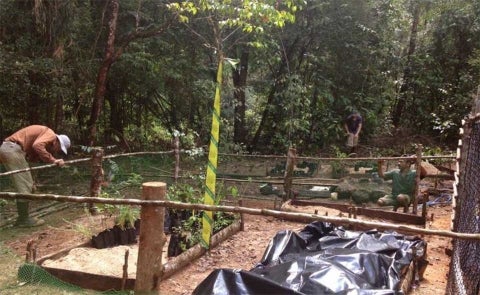
 A view of the village of Pitekele and their tree gardens, tea and rice cultivation. The field station is located at the top of the valley adjacent to the rain forest with the village downstream following the river and valley.
A view of the village of Pitekele and their tree gardens, tea and rice cultivation. The field station is located at the top of the valley adjacent to the rain forest with the village downstream following the river and valley.
 After arriving in Sri Lanka the fellows toured home gardens, and climbed a few small mountains.
After arriving in Sri Lanka the fellows toured home gardens, and climbed a few small mountains.
 Laura drinks a king coconut.
Laura drinks a king coconut.
 Tillekaratne explaining the intricacies of soil.
Tillekaratne explaining the intricacies of soil.
 Blair and Tillekaratne after a long day’s work.
Blair and Tillekaratne after a long day’s work.
 The crew tries to prevent the saw blade from pinching while they cut <em>kitul</em> logs to length.
The crew tries to prevent the saw blade from pinching while they cut <em>kitul</em> logs to length.
 The river was relatively high while the team made boards, so they were able to float the boards back to the nursery in bundles.
The river was relatively high while the team made boards, so they were able to float the boards back to the nursery in bundles.
 Logan happily receives a young coconut.
Logan happily receives a young coconut.
 Tilakareatne, left, stuffs a bag with plants transplanted from his garden to the Yale team’s nursery. A Pitakele resident offers bitter mandarins as a seed source.<br />
Tilakareatne, left, stuffs a bag with plants transplanted from his garden to the Yale team’s nursery. A Pitakele resident offers bitter mandarins as a seed source.<br />
 Nursery beds slowly filling with plants.
Nursery beds slowly filling with plants.
 Logan applies river clay to create a small pond.
Logan applies river clay to create a small pond.
 Bringing chain-link fencing from the road to the field station.
Bringing chain-link fencing from the road to the field station.
 Bulat heppawa with leaves, tobacco, carbonate, and areca nut.
Bulat heppawa with leaves, tobacco, carbonate, and areca nut.
 Two puaks enjoy the sunshine; notice the fruit just below the canopy of the right palm.
Two puaks enjoy the sunshine; notice the fruit just below the canopy of the right palm.
 The Sri Lanka Program for Forest Conservation Field Station and the zones of cultivation for the homegarden.
The Sri Lanka Program for Forest Conservation Field Station and the zones of cultivation for the homegarden.
 Laura arranges the potted flowers for planting in the garden.
Laura arranges the potted flowers for planting in the garden.
 The planting beds filled with top soil and full of newly planted flowers with a wooden trellis to encourage climbers arranged at the back adjacent to the cut bank.
The planting beds filled with top soil and full of newly planted flowers with a wooden trellis to encourage climbers arranged at the back adjacent to the cut bank.
 Teams of children race at their school’s annual parade.
Teams of children race at their school’s annual parade.
 An elephant house made from palms, bamboo, and banana.
An elephant house made from palms, bamboo, and banana.
 Laura and Logan at Bakers Falls, located in Horton Plains National Park.
Laura and Logan at Bakers Falls, located in Horton Plains National Park.
 Blair walking the path to Kirigalpoththa.
Blair walking the path to Kirigalpoththa.
 Laura, Logan, Vinh Lang ’15 M.F., and Blair packed into a motorized tricycle called a “tuk tuk.” Lang, who did research at the Sinharaja Forest and for the Sri Lanka Program for Forest Conservation while a student at F&ES, spent time with the group during a brief visit.
Laura, Logan, Vinh Lang ’15 M.F., and Blair packed into a motorized tricycle called a “tuk tuk.” Lang, who did research at the Sinharaja Forest and for the Sri Lanka Program for Forest Conservation while a student at F&ES, spent time with the group during a brief visit.
 A kitul tapper installing a ladder made from a sapling secured to the kitul by a bandula vine.
A kitul tapper installing a ladder made from a sapling secured to the kitul by a bandula vine.
 Slowly cooking kitul sap almost ready to become penni.
Slowly cooking kitul sap almost ready to become penni.
 Someratna helps in navigating the kekila fern scrubland to locate planting sites for coconuts.
Someratna helps in navigating the kekila fern scrubland to locate planting sites for coconuts.
 A planted seedling.
A planted seedling.